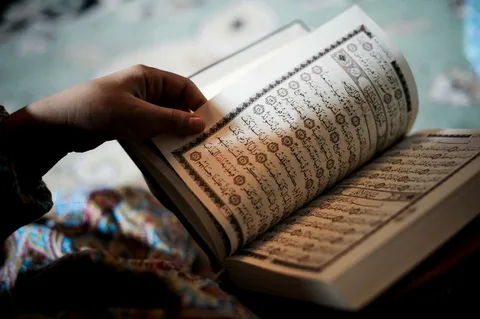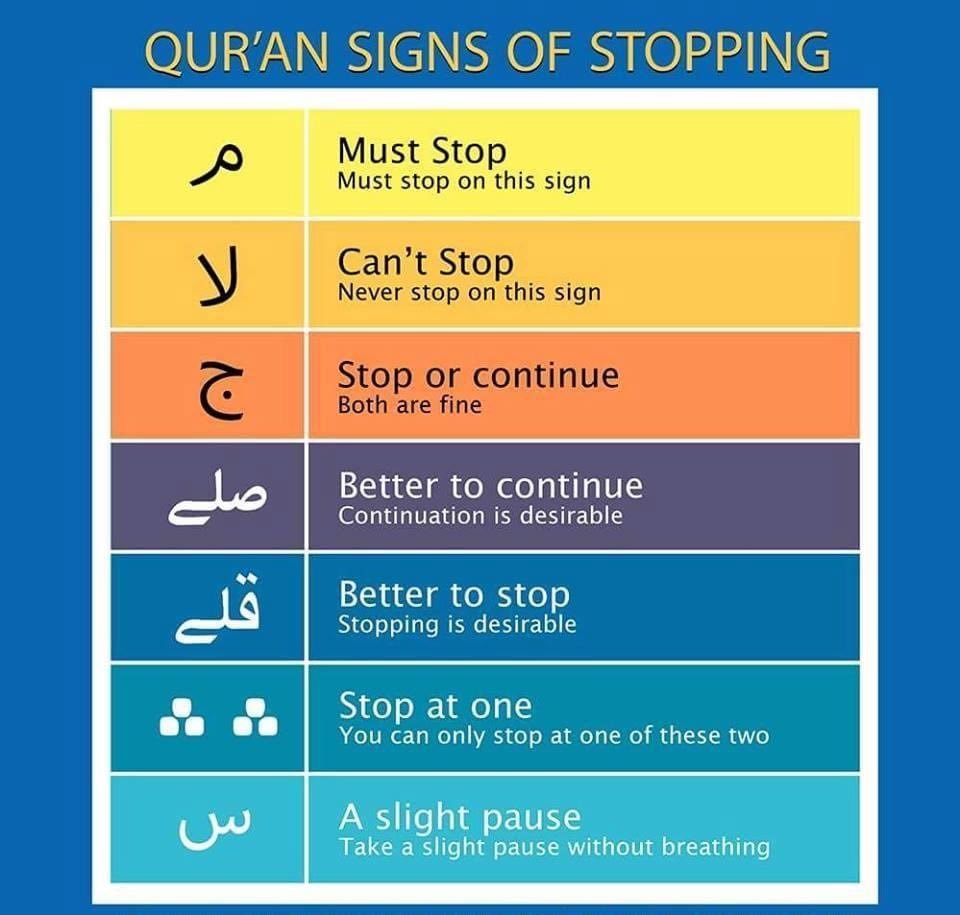Many students around the world strive to master the correct recitation of the Quran Therefore, studying the Tajweed symbols in Quran serves as a guide for readers to pronounce words accurately and apply all Tajweed rules correctly. This ensures that the Quranic meanings are conveyed properly and enhances the beauty of recitation, In this article, we will delve into the details of the Tajweed symbols in the Quran, their meanings, and their importance
Definition of Tajweed symbols in Quran
In the Arabic language, tajweed symbols in Quran or “waqf” (stopping) means to halt or to restrain, in Tajweed, it refers to cutting off the sound at the end of a word temporarily, allowing the reader to breathe to resume the recitation, It does not occur in the middle of a word and The rule for waqf is permissibility unless it leads to a change in the intended meaning, The pause duration is estimated to be around two harakat (movements), It can occur at the ends or in the middle of verses but not in the middle of words or in what is connected in writing, such as the word “أينما” (wherever).
Importance of Tajweed symbols in Quran

Tajweed symbols in Quran play a crucial role in ensuring accurate and beautiful Quranic recitation, preserving its original pronunciation, and enhancing the spiritual experience. Below are the key benefits of these symbols:
Accurate Pronunciation:
Tajweed symbols in Quran provide precise guidelines for pronouncing letters and words correctly, ensuring the accurate conveyance of the Quranic verses’ meanings without distortion. They take into account the articulation points and characteristics of the letters, resulting in precise and correct pronunciation.
Rhythm Organization:
Tajweed symbols in Quran play a vital role in organizing the rhythm and flow of recitation and They indicate places for elongation, pausing, and connecting letters, which contributes to a smoother and more beautiful recitation, creating harmony that makes the recitation more impactful and pleasant.
Spiritual Enhancement:
tajweed symbols in Quran enhance the spiritual connection with the Quran, Correct recitation, and adhering to Tajweed rules, reflect a deep respect and dedication to the sacred text, enhancing the spiritual connection and emotional interaction with the teachings of the Quran.
Preservation of Pronunciation:
tajweed symbols in quran help preserve the original pronunciation of the Quran as taught by the Prophet Muhammad (peace be upon him), This preservation ensures that the Quran is transmitted in its authentic form across generations, maintaining its linguistic integrity and enhancing the unity of the Islamic community in Quranic recitation.
Educational Tool:
Tajweed symbols are an effective educational tool, facilitating the correct teaching and learning of Quranic recitation, Thanks to these symbols, teachers can provide precise and standardized instructions to ensure students learn to recite the Quran correctly.
What are the Tajweed Rules?
Tajweed rules are a set of guidelines governing the correct recitation of the Quran, These rules include various principles that regulate the arrangement of letters, pronunciation, stopping, and starting during recitation, tajweed symbols in Quran aim to preserve Classical Arabic and ensure the accuracy and beauty of recitation, thereby conveying the meanings of the Quran clearly and precisely and these rules are:
Rules of Stopping and Starting: These rules pertain to how one should stop and start during the recitation of the Quran, outlining matters that can lead to distortion of meaning and clarifying what should be observed in the method of stopping and starting. Under these rules, there are several branches, the most important of which are:
- Complete Stop: This is the stop that is good to stop at and good to start with what follows it, as the meaning has been completed and clarified.
- Good Stop: This is the stop that is good to stop at but not good to start with what follows it, due to a connection between what precedes the stop and what follows it.
- Bad Stop: This is the stop that is neither good to stop at nor good to start with what follows it, as it leads to a distortion of meaning and can result in unintended meanings or disrespect towards Allah, an example is stopping at the word “forgives” in the verse: {Indeed, Allah does not forgive association with Him, but He forgives what is less than that for whom He wills} (Quran 4:48).
Rules of Noon Sakinah and Tanween: Noon Sakinah is the noon free from the three vowel marks and has four rules, which also apply to Tanween and The rules are as follows:
- Izhar (Clarification): Linguistically, it means “clarification,” and technically, it means pronouncing the Noon Sakinah and Tanween clearly without nasalization. The letters of Izhar are six: Hamzah, Ha, Ain, Ha, Ghain, and Kha.
- Idgham (Merging): Linguistically, it means “merging,” and technically, it means pronouncing two letters as one, with the second letter being emphasized. The letters of Idgham are five, gathered in the word “Yarmaloon.” and you can read more about tajweed symbols in Quran above.
- Iqlab (Conversion): Linguistically, it means “conversion,” and technically, it means replacing one letter with another, and its letter is Ba only.
- Ikhfa (Concealment): Linguistically, it means “concealment,” and technically, it means pronouncing the Noon Sakinah or Tanween in a way that is between Idgham and Izhar. The letters of Ikhfa are fifteen: “T, Th, J, D, Dh, Z, S, Sh, S, D, T, Dh, F, Q, K.”
Read more
Take class in the quran Online with Tajweed
Ijazah in Quran Recitation and Tajweed Course
Tajweed Stop Signs

The stop signs in Tajweed are vital symbols used during the recitation of the Quran to denote pauses and continuations, significantly affecting accuracy and eloquence in recitation. These tajweed symbols in Quran include several types:
- Waqf Lazim (مـ): Indicates a mandatory stop, as in the verse ” ” He only responds to those who listen ” إِنَّمَا يَسْتَجِيبُ الَّذِينَ يَسْمَعُونَ”.
- Waqf Mamnu (لا): Means not to stop, as in “Those whom the angels take in a state of purity” “الَّذِينَ تَتَوَفَّاهُمُ الْمَلائِكَةُ طَيِّبِينَ”.
- Waqf Mubah (ج): Indicates a permissible stop or continuation, as in “We relate to you their news in truth” “نَحْنُ نَقُصُّ عَلَيْكَ نَبَأَهُمْ بِالْحَقِّ”.
- Waqf Mustahab (صلي أو صلى): Encourages stopping though continuation is preferable, as in “And if Allah should touch you with adversity, there is no remover of it except Him.”“وَإِنْ يَمْسَسْكَ اللَّهُ بِضُرٍّ فَلا كَاشِفَ لَهُ إِلا هُوَ”.
- Waqf Mahzur (قلي أو قلى): Allows continuation though stopping is preferred, as in “Say, ‘My Lord is most knowing of their number. None knows them except a few.’ “قُلْ رَبِّي أَعْلَمُ بِعِدَّتِهِمْ مَا يَعْلَمُهُمْ إِلا قَلِيلٌ
- Signs of Concatenation: Indicate that if the reader stops at one, they must connect with the other, not stop on it, as in“That is the Book, without any doubt. It is a guidance for the righteous.”“ذَلِكَ الْكِتَابُ لا رَيْبَ فِيهِ هُدًى لِلْمُتَّقِينَ”
These symbols are integral to the Quranic script, enhancing the mastery and precise delivery of Quranic style. Moreover, their development and integration into the script underscore their importance in facilitating the clear and accurate transmission of the Quran’s message.
Read about: How to Learn Quran Reading with Tajweed for Beginners: A Comprehensive Guide
How to Learn the Tajweed Symbols?

To learn tajweed symbols in quran effectively, it’s crucial to select skilled teachers fluent in Classical Arabic and Quranic recitation. Choosing a trusted academy like Sheikh Saleh’s Academy, which provides religious and Quranic education globally, ensures exposure to a curriculum designed by experienced instructors. Students begin by mastering Quranic synonyms and accurate recitation to understand Arabic pronunciation. Proficiency in Arabic language, its letters, and pronunciation methods is essential. Focus then shifts to studying each tajweed symbol individually, starting with those indicating mandatory stops (such as “مـ” for obligatory pauses) and progressing to symbols for prohibited or permissible pauses. Listening to teacher guidance and consulting religious texts on the Quran enhances learning effectively. Understanding these tajweed symbols in quran aids in mastering Quranic recitation and pronunciation skills.
Conclusion
Studying Tajweed symbols in Quran is essential for students worldwide aiming to master accurate Quranic recitation. These symbols guide pronunciation and apply Tajweed rules, ensuring precise conveyance of Quranic meanings and enhancing recitation beauty. Tajweed symbols play a vital role in preserving Quranic pronunciation and organizing its rhythm, fostering spiritual connection with its teachings. They serve as effective educational tools at Sheikh Saleh Academy, facilitating correct Quranic recitation teaching and learning.
Shaikh Saleh Academy courses:
- Quran Reading Basics Course
- Quran Recitation with Tajweed Course
- Quran Memorization Courses
- Quran Ijazah Courses
- Islamic Studies Course
- Arabic Language Course
FAQS
What are the Tajweed symbols in the Quran?
tajweed symbols in Quran include markings like “مـ” for mandatory stops, “لا” for prohibited stops, and others indicating recommended or permissible pauses.
What do the symbols mean in the Quran?
These tajweed symbols in quran guide Quranic recitation, indicating where to pause, stop, or continue, ensuring accurate pronunciation and understanding.
What does Tajweed mean in Islam?
Tajweed refers to rules ensuring correct pronunciation and articulation of Quranic Arabic, maintaining the purity of the Quran’s recitation.
Is Tajweed obligatory?
Tajweed is considered highly recommended (mustahabb) to preserve the Quran’s sanctity and convey its message accurately.
Is Tajweed obligatory in Salah?
Basic Tajweed principles are essential in Salah (prayer) to correctly recite Quranic verses, though perfecting Tajweed is not obligatory for the validity of Salah.
Is Tajweed important?
Yes, Tajweed is crucial as it enhances understanding, respect for the Quran, and spiritual connection through precise recitation, reflecting the beauty and essence of the Quranic verses.